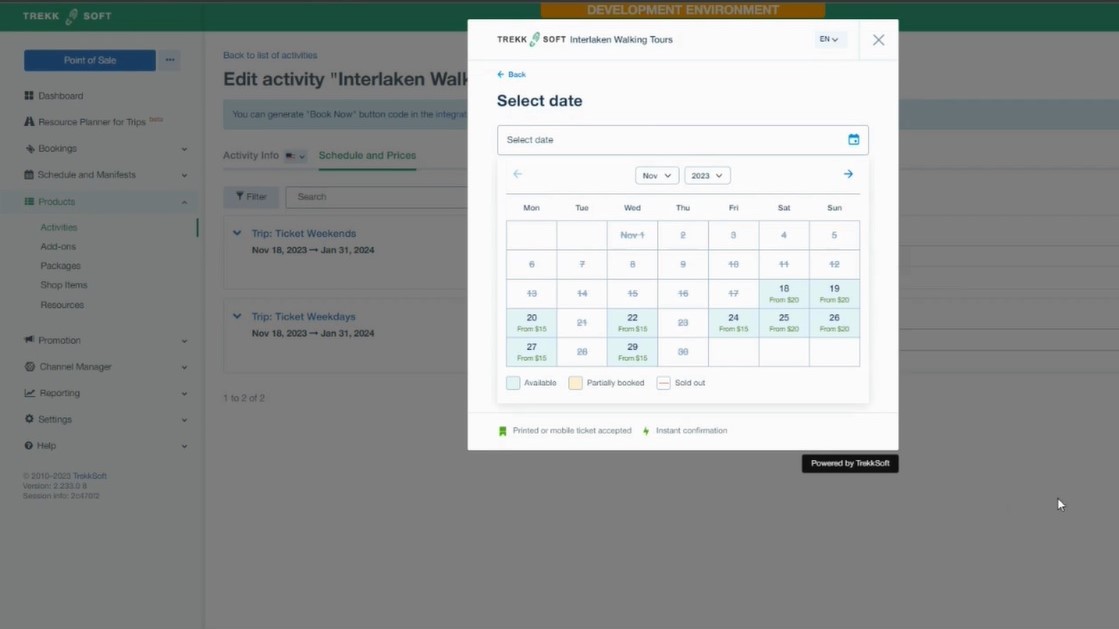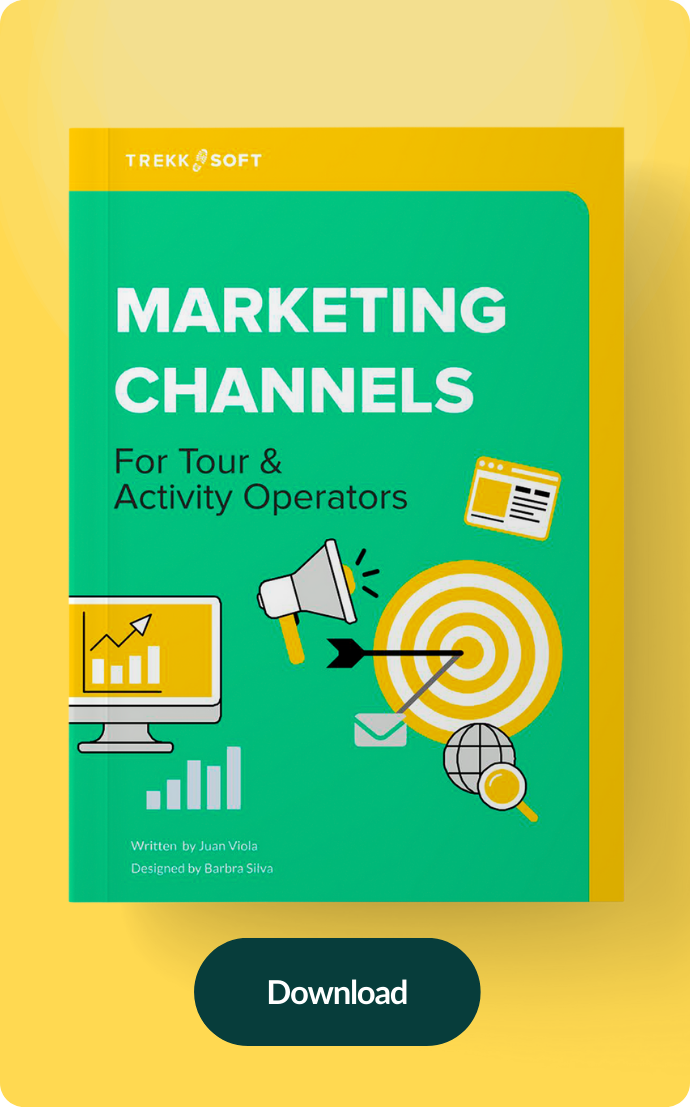Price transparency plays a role in enhancing customer experience and increasing bookings. With the advent of the new prices in calendar feature in Trekksoft's Booking Widget 3.0, tour and activity operators can now strategically utilize this tool to maximize bookings and boost revenue.
So, what makes this feature so significant? The answer lies in the advantages of transparent pricing. According to a study by Frontiers in Psychology, price transparency, characterized by the availability and accessibility of price information, offers several benefits for businesses. Crucially, this openness results in a competitive advantage over businesses that lack clear pricing information. Additionally, it facilitates attracting more genuinely interested prospective clients, ensuring you focus your efforts on those most likely to book your services. Ultimately, being candid about your pricing reduces uncertainty and boosts customer confidence, fostering a more comfortable booking experience.
In this article, we'll discuss the new feature of TrekkSoft and how it can help your price strategies.
Prices in calendar in Trekksoft's Booking Widget 3.0
The prices in calendar feature in Trekksoft's Booking Widget 3.0 is a powerful tool designed to enhance the customer's booking experience. It provides a clear view of the costs associated with a tour or activity, removing any hidden surprises for the customer and fostering a sense of trust.
Transparent pricing not only lowers search costs but also enables customers to find lower prices, leading to increased competition among sellers and benefits for customers. In essence, when prices become more transparent to everyone in a market, the value of each competitor also comes into sharper focus.

Strategies to maximize bookings with prices in calendar
With the new prices in calendar feature, tour and activity operators can leverage several strategies to maximize bookings and enhance customer experience. You can implement dynamic pricing, where operators can adjust prices based on real-time demand, seasonality, or other relevant factors. This strategy not only maximizes bookings during peak periods but also helps maintain competitiveness in the market.
Furthermore, the prices in calendar feature allows operators to create targeted promotional campaigns. You can also implement strategic upselling tactics and display add-ons, upgrades, and complementary services.
1. Highlight special offers and discounts
Placing discounts during low-booking periods is a well-known approach for tour and activity operators. This strategy not only fills tours but optimizes revenue, ensures a steady flow of bookings throughout the year, and helps you attract potential guests with engaging discounts by identifying periods of lower demand.
Seasonal discount - check our next topic to learn more - is just one of the types of discounts you can implement into your price strategy.
Some discounts and offers that you can work with are:
-
Buy one, get one free discount. This type of discount works best for your low-season/low-cost activities. Also, keep your eyes open for great opportunities; for example, if you are based in a romantic destination, this type of offer can be perfect for a Valentine's Day offer.
-
Early payment discounts. Do you want to increase revenue by selling high-season tours while still in the low season? This strategy can provide discounts for those who book earlier, providing you with continuous cash flow and reducing the search for clients to fill vacancies.
-
Price bundling. For this strategy, the goal is to provide discounts for clients buying more than one service. For example, if the client buys 3 different outdoor activities, they get a discount. You can also apply this strategy to the cross-selling method, where the customers purchase complementary items and increase their purchase quantity - like video session or extra time.
-
Referral discounts. Offering an incentive to clients referring to your business is a great strategy to improve customer loyalty - both for the who is referring and the referred.
Now that you know some strategies that you can work with, keep in mind that placing discounts and offers needs to be planned ahead, not just because it helps you keep your bookings organized but also to reach more customers. According to Think with Google research, "in the 12 weeks leading up to a trip, there are 3X more experience searches than hotel searches."
Another reason for planning the discounts is that the visibility of these special offers and discounts within the booking calendar is critical to this strategy. The discounts and offers not only catch the eye of budget travelers actively seeking deals but also become a factor for those who might be flexible with their travel dates.
For more information about increasing booking during low seasons, here are the 6 key strategies to make the most of the low season.
2. Implementing dynamic pricing for tour and activity operators
Dynamic pricing is another powerful strategy that can be effectively implemented using the new prices in calendar feature. You can optimize profits by adjusting prices based on demand, seasonality, and other relevant factors. As described by Hubspot, "Dynamic pricing — also known as surge pricing, demand pricing, or time-based pricing — is a strategy where businesses adjust the prices of their offerings to account for changing demand. For instance, an airline will shift seat prices based on seat type, number of remaining seats, and time until the flight."
This approach to pricing allows tour and activity operators to adjust prices according to demand and needs. Make sure that when testing new prices, you keep in mind these. tips:
-
Work with price tests over a more extended time period. This not only avoids mistakes by a complex price range but also avoids any irritated customers who paid a higher price for a tour. Your prices need to make sense to the customer; for example, why would the same activity have different prices if they both occur on the same day, but one is in the morning, and the other is in the evening? If a logical reason is highlighted in your activity's description, go ahead.
-
Establish your base rate. Whether you choose to work with seasonal pricing or discounts, defining the minimum you're willing to charge is the kickstart for a strong price strategy.
-
Consider seasonal pricing. Tourism businesses are well familiar with this pricing strategy, so when organizing your prices in the calendar, take into consideration your periods of high and low demand. During the high tourist season, you can increase prices to maximize profits, while in the off-peak season, lower prices can attract tourists looking for a budget-friendly option.
-
Track your results. How is your tour or activity performing compared to previous seasons? Make data-based decisions to keep increasing revenue, so ensure you're on top of your sales, revenue, and customer satisfaction numbers.
Implementing dynamic pricing also encourages you to be more responsive and adaptable to sudden changes in the market. This could include instabilities in the number of tourists, changes in weather conditions that might affect outdoor activities, or variations in the popularity of specific tours or activities.
The price strategy also helps maintain a competitive advantage. You can monitor competitor pricing and market trends and adjust your prices accordingly.
Read 4 price strategies to maximise profits during the high season.
3. Enhance your upselling and cross-selling tactics
Upselling and cross-selling are strategies very common in the tourism industry. While upselling aims to encourage customers to opt for a higher-end product than the one they had initially shown interest in, on the other hand, cross-selling involves promoting products that are connected to items the customer either already owns or is planning to purchase. These strategies can significantly increase your revenue and customer satisfaction.
When showing prices in the calendar - remember the discount tactics we have mentioned previously - offering discounts on tours or activities to encourage the purchase of add-ons or to upgrade their experience is a great strategy to increase revenue.
To clarify, let's see some practical examples.
Upselling, in the context of a tour operator, could involve encouraging a customer who's booked a basic sightseeing tour to upgrade to a premium package that includes additional features like meals, exclusive guides, or private transportation. This strategy not only increases the overall revenue per customer but also enhances the customer's experience, leading to potential repeat bookings and referrals.
Cross-selling, for an adventure activity operator, might look like offering customers who've booked a scuba diving session add-on services like underwater photography, equipment rentals, or even post-dive relaxation services such as massages. The customer, therefore, gets a more comprehensive experience, and the business benefits from expanded revenue.
When used smartly and effectively, these strategies not only lead to an increase in immediate revenues but also help build a loyal customer base that can offer long-term returns.
To learn more about upselling and cross-selling and how they benefit the tour and activity business read how to upsell and cross-sell in the tourism industry.
Step-by-step guide to utilizing prices in calendar
Implementing the prices in the calendar feature in Trekksoft's Booking Widget 3.0 is straightforward and user-friendly.
In each schedule's price category, you can define which should represent the "from price" on the widget calendar.
For more information and a detailed video tutorial to help you navigate this feature seamlessly, check our article What's new with our Booking Widget 3.0? in TrekkSoft's Help Center.
Conclusion
The prices in calendar feature in Trekksoft's Booking Widget 3.0 is an excellent ally for tour and activity operators. With this feature, operators can boost bookings considerably and enhance the overall customer experience.
This innovation provides operators with a canvas to experiment with a myriad of pricing strategies, to test, tweak, and tailor them until you find the one that aligns best with your specific business goals and customer base.
The prices in calendar feature brings transparency, which builds trust, eliminates any potential for unpleasant surprises, and paves the way for a smoother customer journey. Start your journey with the prices in the calendar feature today and set your business on the path to success.

.png)

